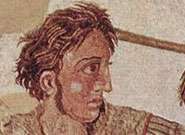Experts question claim that Alexander the Great's half-brother is buried at Vergina

The tomb was discovered during the excavation of a large mound - the Great Tumulus - at Vergina in 1977. Along with many treasures including ceremonial military equipment, bronze utensils, silver tableware, and gold wreaths, the tomb contained two sets of skeletal remains. Those of a man were found in a gold casket in the main chamber and those of a woman in a smaller gold casket in the second chamber. Both individuals had been cremated and evidence of a wooden funerary house containing a pyre was also found near the tomb.
Dr Jonathan Musgrave of the University of Bristol's Centre for Comparative and Clinical Anatomy and colleagues argue that evidence from the remains is not consistent with historical records of the life, death and burial of Arrhidaios, a far less prominent figure in the ancient world than his father Philip II.
The male skull appears to have a healed fracture on the right cheekbone and a marked asymmetry in the wall of the right maxillary sinus. History records that Philip II lost his right eye at the siege of Methone in 355-4 BC - an injury which would be consistent with this damage to the skeleton.
The colour and fracture lines of the bones suggest they were cremated 'green' (with flesh still around them) rather than 'dry' (after the flesh had been decomposed by burial). Arrhidaios was murdered in the autumn of 317 BC; his remains, some suggest, were subsequently exhumed and reburied between four and 17 months later. However, the existence of the funeral pyre indicates that the bodies were cremated at Vergina. As Greek beliefs would never have countenanced contact with a decomposing corpse, Arrhidaios would not have been exhumed, moved and then cremated 'green'.
From the historical account of their deaths and committals, it is thought that Arrhidaios was buried along with his wife Eurydice and her mother Kynna. However, the tomb contains remains from only two individuals. The female remains belong to a woman aged between 20 and 30 whereas Eurydice seems to have been no more than 19 years old when she died.
Dr Musgrave said: "The aim of this paper is not to press the claims of Philip II and his wife Cleopatra but to draw attention to the flaws in those for Philip III Arrhidaios and Eurydice. We do not believe that the condition of the bones and the circumstances of their interment are consistent with descriptions of the funeral of Arrhidaios, his wife and his mother-in-law."
More information: The paper is published in the International Journal of Medical Sciences. www.medsci.org/
Provided by University of Bristol

















